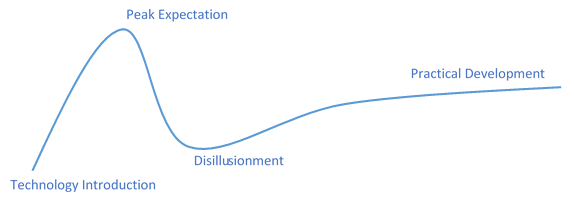Let us know what type of content you'd like to see more of. Fill out our three question survey.
Getting Past the Blockchain Hype Cycle
Feb 15, 2018
Distributed Ledger Technologies (DLTs), commonly referred to as blockchain applications, are possibly the most talked about innovation of the day. And the most commonly discussed DLT applications are those that involve financial transactions with cryptocurrencies. Fortune Magazine recently listed “The Fintech Renaissance” as the second-most important technology trend of 2018, and with good reason. Last month Bitcoin saw more than 400,000 transactions per day. Despite warnings of Bitcoin’s volatility, the increased investment in cryptocurrencies is hard to ignore.
But what about all of the other promises of DLTs? There are no shortage of articles written about their impact on data security, the value of smart contracts to create efficient online transactions, and the value of data democratization and transparency through shared ledgers. While there are case studies for each of these promising areas, distributed application developers are in short supply, and active implementations for global development projects are rare. As a result, I get the sense that blockchain may be entering the peak if its hype cycle.
Peak Expectation
As followers of technology trends, our ICT team is aware of the excitement a new technology can bring. But we also know that new technologies can lead to great disappointment when they fail to live up to expectations. One of my favorite representations of this idea can by described by Amara’s Law, which states that, “We tend to overestimate the effect of a technology in the short run and underestimate the effect in the long run.” This can be seen in the curve referred to as the Hype Cycle, which begins with a trigger point for a new technology, soon after reaches a peak of inflated expectations, followed by a period of disillusionment, and finally an era of slow growth and adoption of the technology as it reaches sustainable productivity.

This is, of course, a simplification of the many ways technologies proliferate throughout society, but within the context of DLTs, I think that we may be entering the top end of our period of inflated expectations, and are beginning to see a blockchain backlash. I would argue that this is because DLTs are still maturing; they can be theoretically complex, and even quite boring—but in a way that knowledge management is boring. You know—really crazy useful and even required for all of our technology to work—but boring. When was the last time you read an article about the way SQL databases are changing the world? Because they are….
I digress. Let’s look at a similar case study to the blockchain effect.
The Harvard Business Review article, The Truth About Blockchain, draws comparison to the development of Transmission Control Protocol, also referred to as TCP/IP. Early uses of TCP/IP enabled peer-to-peer computer messaging—hardly a novelty at the time—but 30 years later was the enabling technology for Amazon.com to essentially replace brick-and-mortar bookstores. Five to 10 years into the implementation of TCP/IP, it would have been hard to see it as a revolutionary technology that would change the future of digital communication. But today, by internet standards, the technology is almost as necessary as the air we breathe.
Is DLT the same…? We’re not sure yet.
Getting Practical with DLTs
As adherents to human-centered design principles, our team places great value on the need to understand culture and context before offering technology solutions. That being said, you can’t offer technology solutions if you don’t understand a technology. Therefore, our team has undertaken a series of R&D efforts to build blockchain applications in-house. Leveraging Hyperledger Fabric, one of the flagship blockchain technologies being developed by the Hyperledger Foundation, we have successfully developed a smart contract application and functional API that manages data on seating locations around the office, and even allows us to offer seats for sale to willing buyers! We haven’t yet discussed this with building management, but we have enjoyed the practical nuances of using the technology for our own research purposes.
Applying this concept to global development challenges, a couple of project implementations come to mind. Land tenure and property rights, for example, are key to economic growth, and competition for land often leads to conflict. DLTs could play a role in creating a central location for land records management and transparent governance, potentially decreasing the likelihood of violent disputes. Another example is that of supply chains, which rely on trust between parties to care for goods between transactions, and to be honest about the origin of an item. DLTs can provide an immutable ledger than ensures that all parties have the same, unfalsifiable information about the history of items along the supply chain.
Looking Ahead
These are just two of many examples we are actively exploring. And as we look ahead to the rest of 2018, our plan is to take our technical learning and apply it to practical problems faced by our projects. So while we at DAI don’t know what the future of DLT will bring, what we do know is that it potentially offers new solutions to old problems, and that we plan to test the technology over the coming year.
And that isn’t boring at all. I actually think it’s very exciting.
To learn more about blockchain for international development, we recommend signing for TechChange’s course: TC116.